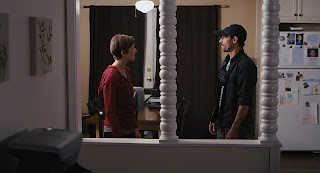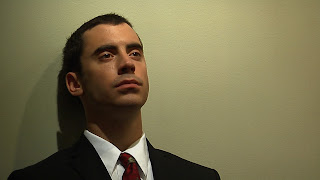VOD Review - Hale County This Morning, This Evening
The nominations for the 91st Academy Awards were announced on January 22. This film was listed as one of five for Best Documentary Feature. It's the shortest of the five selections. This could be because the film has no narration and no standard interviews. Looking at the film, one could question if director RaMell Ross, a black photographer and basketball coach, simply forgot to edit in his narration or sit-down interviews. Looking at the film, one could question if this is just the rough cut of the movie that only has the b-roll and not the total substance. By the end, my sense is that it isn't a rough cut. Yet, it comes across as one but feels a lot more cohesive and more of a piece than something like Kirsten Johnson's Cameraperson (2016).
What Johnson's film is and what Ross's film could be considered to be is a collage film, a film that's pieced together from disparate or non-related pieces. Cameraperson was literally a patchwork of outtakes from Johnson's various films over many years, if not decades. She wasn't initially intending to put those pieces together in one film. They were pieces to other stories that got cut. That made Johnson's film a bit unusual. Other filmmakers have done it like Joe Dante's The Movie Orgy (1968), but typically it's something that's really rare.
More common is someone who collects or compiles home movies as was the case with Jonathan Caouette's Tarnation (2003), which was made up of home movies over 20 years, the course of his life. The focus of that movie was Caouette's relationship with his mother. What else is common is someone who collects or compiles news footage or news archives as was the case with Jason Osder's Let the Fire Burn (2013), Rory Kennedy's Last Days in Vietnam (2014) or Daniel Lindsay and TJ Martin's LA 92 (2017). All those films had a focus as well, a singular subject or event around which to build a collage.
Often, these films are also made with the filmmaker looking backward. A filmmaker can be participatory as was the case with Caouette's film, but still the movies feel like memories or flashbacks. It's not that it's a bad thing because all those aforementioned films are very powerful and very well crafted, but many of them don't feel as present as this one does. Ross isn't a filmmaker looking backward. He's looking forward. It seems as if his intention from the start was to make this film as a collage. In that, it doesn't seem as random as Johnson's film but can be more akin to that than Caouette's or Osder's or Kennedy's films.
Ross though doesn't seem to have a singular subject or event around which he's building this collage. Arguably, you could say that his subject is the titular location. The film is set in Hale County, Alabama, a very rural, impoverished and predominantly black area. There isn't much in the way of development. The most activity occurs in a small town in the center of the county called Greensboro. One of the shots showing the most people is one where Ross is seemingly driving west down Main Street, literally what it's called, through downtown Greensboro, a space that's only four of five blocks and that looks like it's barely been modernized from the Old West times. We even see some people riding horseback.
Yet, if Ross has a thesis to his film, it's probably what he captures from a man who is sitting in a classroom for some unknown reason. The man talks about the joy of rural life and the joy in the lifestyle of the people there that has been grown out of its poverty. To the man, he likes rural life and he doesn't even know what poverty is. Ross seems to want to be on that wavelength, the one that mostly sees the joy of rural life, the goodness of it and the people in general happy spirits. He doesn't suggest that it's all good and that it's all happy.
We see moments of sadness like that of a baby's funeral and the grief from that, or a police stop and the worry from that. We even see moments of anger or frustration like that of young parents dealing with newfound parenthood and having to find work or some direction for their lives. However, Ross never dwells in those things. It's not to say he brushes over them. He simply never dwells in them as he does other things. He dwells on shots of fields and of sunshine through trees. He dwells on a boy playing basketball or on a toddler running around the living room.
The way he focuses on things makes you wonder what he's trying to say beyond this is life and these are people. His camera is just simply a window or a series of windows. In that, it's not that far flung from Kevin Macdonald's Life in a Day (2011), which was just snapshots, glimpses into moments of life, trying to make beauty out of the banal. I personally prefer a movie with more of a story to tell or that digs more into the people involved. This one doesn't cut it in that regard.
I'd point to documentaries like Lofty Nathan's 12 O'Clock Boys (2014) or Jonathan Olshefski's Quest (2017). It wasn't a documentary but another, recent film that I think does what this film does or is trying to do but with more aplomb is Amman Abbasi's Dayveon (2017). It's not to say that I don't appreciate the existence of this movie. I don't even have a problem with its Oscar nomination. People should see it for sure. It's just not a great film in my opinion.
Not Rated but contains language.
Running Time: 1 hr. and 13 mins.
Available on PBS.org until February 25.
Available on iTunes.
What Johnson's film is and what Ross's film could be considered to be is a collage film, a film that's pieced together from disparate or non-related pieces. Cameraperson was literally a patchwork of outtakes from Johnson's various films over many years, if not decades. She wasn't initially intending to put those pieces together in one film. They were pieces to other stories that got cut. That made Johnson's film a bit unusual. Other filmmakers have done it like Joe Dante's The Movie Orgy (1968), but typically it's something that's really rare.
More common is someone who collects or compiles home movies as was the case with Jonathan Caouette's Tarnation (2003), which was made up of home movies over 20 years, the course of his life. The focus of that movie was Caouette's relationship with his mother. What else is common is someone who collects or compiles news footage or news archives as was the case with Jason Osder's Let the Fire Burn (2013), Rory Kennedy's Last Days in Vietnam (2014) or Daniel Lindsay and TJ Martin's LA 92 (2017). All those films had a focus as well, a singular subject or event around which to build a collage.
Often, these films are also made with the filmmaker looking backward. A filmmaker can be participatory as was the case with Caouette's film, but still the movies feel like memories or flashbacks. It's not that it's a bad thing because all those aforementioned films are very powerful and very well crafted, but many of them don't feel as present as this one does. Ross isn't a filmmaker looking backward. He's looking forward. It seems as if his intention from the start was to make this film as a collage. In that, it doesn't seem as random as Johnson's film but can be more akin to that than Caouette's or Osder's or Kennedy's films.
Ross though doesn't seem to have a singular subject or event around which he's building this collage. Arguably, you could say that his subject is the titular location. The film is set in Hale County, Alabama, a very rural, impoverished and predominantly black area. There isn't much in the way of development. The most activity occurs in a small town in the center of the county called Greensboro. One of the shots showing the most people is one where Ross is seemingly driving west down Main Street, literally what it's called, through downtown Greensboro, a space that's only four of five blocks and that looks like it's barely been modernized from the Old West times. We even see some people riding horseback.
Yet, if Ross has a thesis to his film, it's probably what he captures from a man who is sitting in a classroom for some unknown reason. The man talks about the joy of rural life and the joy in the lifestyle of the people there that has been grown out of its poverty. To the man, he likes rural life and he doesn't even know what poverty is. Ross seems to want to be on that wavelength, the one that mostly sees the joy of rural life, the goodness of it and the people in general happy spirits. He doesn't suggest that it's all good and that it's all happy.
We see moments of sadness like that of a baby's funeral and the grief from that, or a police stop and the worry from that. We even see moments of anger or frustration like that of young parents dealing with newfound parenthood and having to find work or some direction for their lives. However, Ross never dwells in those things. It's not to say he brushes over them. He simply never dwells in them as he does other things. He dwells on shots of fields and of sunshine through trees. He dwells on a boy playing basketball or on a toddler running around the living room.
The way he focuses on things makes you wonder what he's trying to say beyond this is life and these are people. His camera is just simply a window or a series of windows. In that, it's not that far flung from Kevin Macdonald's Life in a Day (2011), which was just snapshots, glimpses into moments of life, trying to make beauty out of the banal. I personally prefer a movie with more of a story to tell or that digs more into the people involved. This one doesn't cut it in that regard.
I'd point to documentaries like Lofty Nathan's 12 O'Clock Boys (2014) or Jonathan Olshefski's Quest (2017). It wasn't a documentary but another, recent film that I think does what this film does or is trying to do but with more aplomb is Amman Abbasi's Dayveon (2017). It's not to say that I don't appreciate the existence of this movie. I don't even have a problem with its Oscar nomination. People should see it for sure. It's just not a great film in my opinion.
Not Rated but contains language.
Running Time: 1 hr. and 13 mins.
Available on PBS.org until February 25.
Available on iTunes.















Comments
Post a Comment